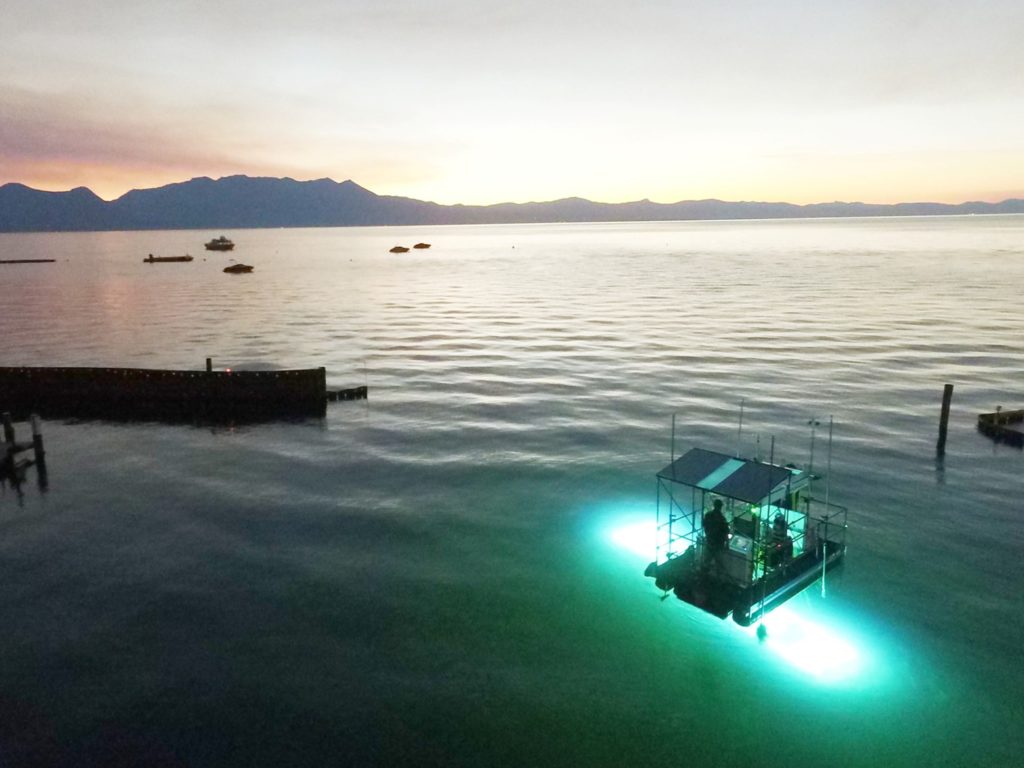Tahoe RCD leads aquatic invasive plant (AIP) control efforts in the Lake Tahoe Basin and continually seeks innovative technologies and methods to improve treatment efficacy and efficiency.
Attempts to locally control or eradicate AIP, specifically Eurasian watermilfoil (Myriophyllum spicatum) and curly-leaf pondweed (Potamogeton crispus), have been ongoing in Lake Tahoe since 2006. Gas-permeable bottom or benthic barriers and diver-assisted suction removal, when used in combination throughout the growing season (May until November), have proven successful. While this combination of methods is effective in an open water setting such as Emerald Bay, site-specific limitations do exist. Wave action, lake bed morphology, high boater use areas, and high turbidity can impede the effectiveness of these methods.
Research indicated that using ultraviolet C (UV-C) light, a short-wave electromagnetic radiation light that damages the DNA and cellular structure of aquatic plants and their fragments, could be an effective new method to kill and control AIP species, as laboratory tests resulted in complete mortality when exposure times of more than 5 minutes were applied. This technology was applied in Lake Tahoe to determine the full potential of UV-C light treatment as a new method to enhance and support current efforts in the treatment of AIP.

The UV-C Light Plant Control Pilot Project (Project) was funded by the California Tahoe Conservancy (Conservancy) and Tahoe Fund and managed by Tahoe RCD. UV-C light was applied to three treatment areas: 1) closed marina system (Lakeside Marina or LSM); 2) adjacent open water or littoral environment (Lakeside Beach or LSB-Swim); and 3) an open water environment (immediately adjacent to the Lakeside Marina bulkhead with water taxi use (LSB-Taxi). UV-C light treatment was conducted between June 23, 2017 and September 11, 2017. Associated macrophyte surveys and biomonitoring (i.e., benthic macroinvertebrates, periphyton, zooplankton, phytoplankton and chlorophyll-a) were conducted pre-treatment,
immediately post-treatment, and long-term post-treatment. Plant response to UV-C light treatment was measured one year after treatment in 2018, and through the 2018 growing season, with the following project milestones:
UV-C light is an effective tool in treating microbes and other living organisms and is currently used in other applications such as food, air and water purification. The Project assists with determining the optimum intensity and duration of UV-C light treatment that is necessary for
control of AIP, specifically Eurasian watermilfoil (EWM) and curly-leaf pondweed (CPW). AIP control efforts are anticipated to result in improvements to water quality, native fish habitat, and recreational access for swimming and boating. The Project provides a significant regional
benefit by increasing the variety and application of methods available for controlling AIP, potentially at greater efficiencies and less cost.